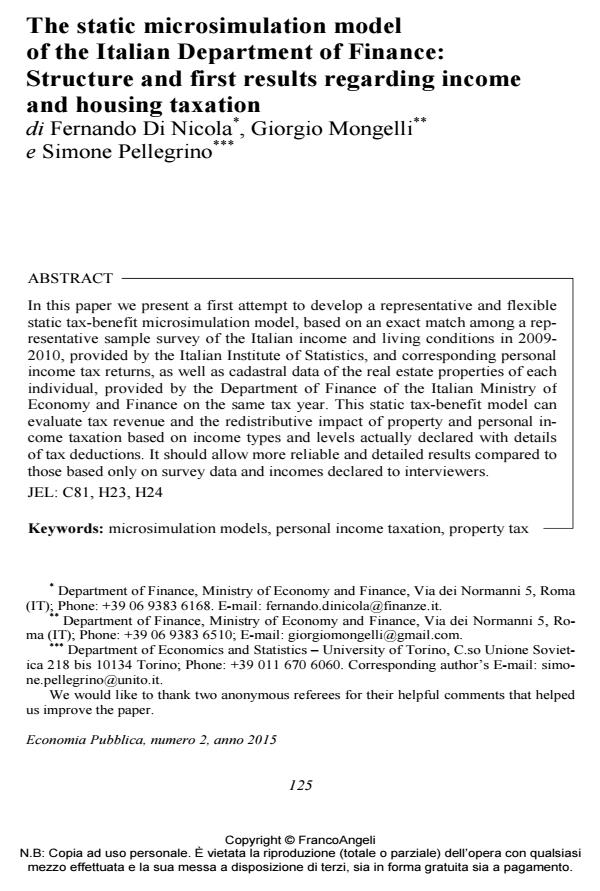The static microsimulation model of the Italian Department of Finance: Structure and first results regarding income and housing taxation
Journal title ECONOMIA PUBBLICA
Author/s Fernando Di Nicola, Giorgio Mongelli, Simone Pellegrino
Publishing Year 2016 Issue 2015/2
Language English Pages 33 P. 125-157 File size 368 KB
DOI 10.3280/EP2015-002004
DOI is like a bar code for intellectual property: to have more infomation
click here
Below, you can see the article first page
If you want to buy this article in PDF format, you can do it, following the instructions to buy download credits

FrancoAngeli is member of Publishers International Linking Association, Inc (PILA), a not-for-profit association which run the CrossRef service enabling links to and from online scholarly content.
In this paper we present a first attempt to develop a representative and flexible static tax-benefit microsimulation model, based on an exact match among a representative sample survey of the Italian income and living conditions in 2009-2010, provided by the Italian Institute of Statistics, and corresponding personal income tax returns, as well as cadastral data of the real estate properties of each individual, provided by the Department of Finance of the Italian Ministry of Economy and Finance on the same tax year. This static tax-benefit model can evaluate tax revenue and the redistributive impact of property and personal income taxation based on income types and levels actually declared with details of tax deductions. It should allow more reliable and detailed results compared to those based only on survey data and incomes declared to interviewers
Keywords: Microsimulation models, personal income taxation, property tax
Jel codes: C81, H23, H24
- The Evolution of the Italian Framework to Measure Well-Being Fabio Bacchini, Barbara Baldazzi, Rita De Carli, Lorenzo Di Biagio, Miria Savioli, Maria Pia Sorvillo, Alessandra Tinto, in Journal of Official Statistics /2021 pp.317
DOI: 10.2478/jos-2021-0014 - The contribution of tax-benefit instruments to income redistribution in Italy Stefano Boscolo, in ECONOMIA PUBBLICA 2/2022 pp.181
DOI: 10.3280/EP2022-002001 - Analisi distributiva dell'IRPEF utilizzando i microdati di fonte fiscale Paolo Di Caro, in ECONOMIA PUBBLICA 1/2017 pp.35
DOI: 10.3280/EP2017-001002 - Effective marginal and average tax rates in the 2017 Italian tax-benefit system Fernando Di Nicola, Melisso Boschi, Giorgio Mongelli, in ECONOMIA PUBBLICA 3/2018 pp.67
DOI: 10.3280/EP2017-003003
Fernando Di Nicola, Giorgio Mongelli, Simone Pellegrino, The static microsimulation model of the Italian Department of Finance: Structure and first results regarding income and housing taxation in "ECONOMIA PUBBLICA " 2/2015, pp 125-157, DOI: 10.3280/EP2015-002004